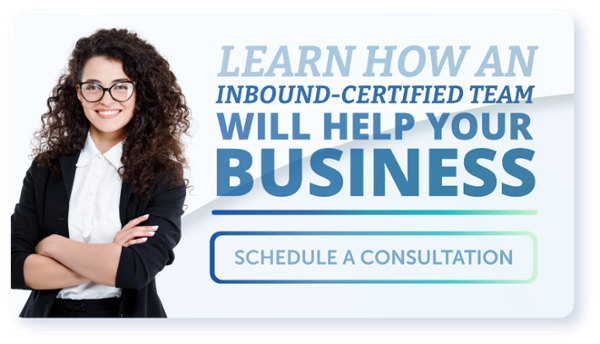Experience firsthand how Mind & Metrics + Supered.io can help your business streamline execution, eliminate unnecessary back-and-forth, and ensure AI accelerates growth—without the chaos.
5 Reasons Your Sales Team Should Be Inbound Sales Certified
An inbound sales certification can help your team adapt to changing buyer behavior. Today’s customer seeks out information before they connect with a salesperson. Know why? Trust issues.
What occupations do you consider trustworthy? Like most people, you’d likely list jobs like doctor, firefighter, or teacher. What doesn't come to mind? Salespeople.
As a sales professional, you likely find this frustrating. But, it’s true. In a poll by HubSpot, only 3% said salespeople are trustworthy. For many, the thought of a salesperson reminds them of their last visit to the used car lot.
Technically Speaking, Everyone is in Sales
That industry gives salespeople a bum rap. People often view salespeople as aggressive, dishonest, and manipulative. And 50% of prospects say salespeople are pushy.
If you want customers to trust your sales team, you don’t want them to use even subtle aggressive sales tactics. Inbound sales can quash those bad habits. Here’s how an inbound sales certification can help your team.
![]()
1. Follow Along With Your Buyer’s Journey
Inbound sales has changed the game. Unlike some traditional methods, inbound sales doesn’t push a quick sale and consider it a win. That’s like breaking out the champagne for the first run of the World Series. There’s still a long way to go.
An ethical approach to marketing and sales is critical. With inbound sales, you focus on understanding your customer’s needs, helping them and qualifying them as a good fit. Making the fastest sale at the expense of the customer might help you meet your immediate goals. But, it won’t last. You want repeat business, a good reputation, and the easiest type of sale; the referral.
Unhappy customers will hurt your bottom line in the long run. With social media outlets, they will advertise their bad experience widely, some will leave bad reviews, and most will refuse to work with you ever again.
It’s much better to turn away prospects you can’t help. But to do so, you’ll need to know exactly where your customer is in the process of solving for their problem. Otherwise, even good intentions can result in a 'closed - lost'.
2. Qualify Better For Poor-Fit Customers
Having a customer call to hire you without an effort on your part sounds like a dream client. Why question it?
But, even customers who seem excited about your services need to be qualified. Don’t skip the exploratory meeting. It’s hard to turn down a substantial sale. Especially when you need capital for employees, equipment, and expansion.
These types of clients can have unrealistic goals. They might not have an infrastructure that can even use what you have to offer.
Your team will need to handle this situation with finesse. Explain why you don’t think you’re a good fit at the moment. Be clear. Often customers will appreciate your honesty.
Inbound sales helps potential clients even when they don’t become customers. Poor-fit customers cost more in the long run anyway. They can lead to a bad reputation, psychological stress, and even legal fees.
When you don’t deliver what poor-fit clients are looking for, they’re going to be unhappy no matter what you do. You’ll waste time. Your sales team will dread working with customers who complain constantly. And poor-fit customers take attention from more deserving customers.
3. Help Develop a Content Strategy
Your team can make the most impact if they direct their blows wisely. They don’t want to be like a bad boxer who swings only to strike the air. Develop the right content to pique the interest of future customers and land a direct hit. The flywheel model centers on creating a frictionless experience for customers by delivering valuable content and removing all barriers to conversion.
Attract. Draw in site visitors with useful content that showcases the value of your product or service. By employing a marketing and paid media strategy that helps the right people discover your business, and providing free educational content such as blog posts and eBooks to visitors, you spark their interest and make it easy for them to understand the solutions you offer.
Engage. Open a line of communication with your leads to help guide them towards making a decision. Emails that are triggered by certain customer behaviors help move them to act while engaging with them on their own timeline.
Delight. Nurture your relationships with customers. Implementing multichannel customer service with online messaging, email, and phone availability shows you always welcome questions, concerns, and feedback, as does distributing customer surveys. Loyalty programs encourage customers to keep coming back.
4. Spend Their Time Efficiently
Your team only has so much time in a day. A lot of time can be wasted trying to convince passive buyers to make a purchase or hire you. Your team needs to focus on active buyers.
Active buyers have already done their own research and know what they want. Figure out a few things. First, the economics. Do they have a sufficient budget to hire you? Second, timing. Is now the right time to work together? Third, location. Can you accommodate their needs?
Social media is a great way to engage with active buyers. Publish valuable content. Interact with potential clients. Comment on posts. Try to help as much as possible. Answer their questions. You’ll be their trusted expert in no time.
5. Plan Effective Discovery Calls
Once you connect with a qualified buyer, make a discovery call. This is where you get crucial information about the client. Use these three acronyms, courtesy of HubSpot.
CGP. Discuss the challenges the client is facing. Link their challenges to the goals they have. Figure out their plan to address the problem.
TCI. Find out how much time they have to solve the problem. What’s the consequence of not achieving their goal? What will be the implications of achieving the goal?
Discuss the budget they have. Identify the costs that will be involved. How does this affect their current spend? Figure out who has the authority to make the necessary decisions.
It’s not all business on the call. Now’s the time to use your sales chops. Build a rapport. Ask open-ended questions. Find out what’s going on at their company or in their town. You’re not just a salesperson, you’re a friend.
Get Your Inbound Sales Certification
Inbound sales requires you to understand your buyer’s goals, their challenges, and what it means to work together. Know where they are in their journey. A quick win might come at the cost of your long-term success. Dedicate your valuable time to the most effective areas on the right customers.
Visit Mind & Metrics to find out how sales certification programs can help grow your business. Learn how inbound marketing helps your brand show up at the right time. Identify your company’s current sales strengths and weaknesses. Schedule a consultation today!

